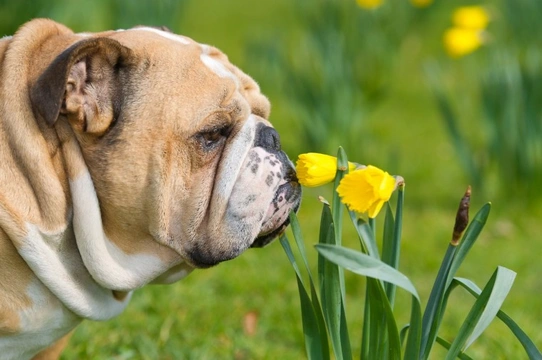
Daffodil toxicity in dogs: A Springtime hazard
Every season’s weather and conditions presents new challenges for dog owners when it comes to plants and situations that can pose a hazard to dogs, but simply knowing what they are and how they pose a hazard can ensure that you keep your dog safe and well all year round.
The sight of those very first early springtime daffodils heralds the onset of the lighter nights and milder weather in many people’s minds, and seeing those very first yellow flowers opening can really lift the spirits and put us in mind of nicer weather to come.
Daffodils tend to appear outdoors in gardens and parks in the springtime, and they’re also commonly sold in pots to keep indoors, and as cut flowers to place in vases too. Ultimately, for a couple of months of the year, it can seem like you see daffodils everywhere you turn, and these bright, cheery flowers are very decorative and a nice sight too.
However, daffodils are toxic to dogs, and the sheer number of them around in spring and the range of different places and formats they can be found in makes them a springtime dog hazard that all owners should be aware of, just to be on the safe side.
In this article we’ll talk a little more about why daffodils are toxic to dogs, what part of the daffodil is toxic to dogs, and the symptoms of daffodil poisoning in dogs to help you to avoid any issues. Read on to learn more.
What makes daffodils toxic to dogs?
There is a specific naturally occurring substance found in daffodils that makes them toxic to dogs, which is called lycorine; this is a type of crystalline alkaloid that is very toxic to most species of animals, including humans as well as dogs! It is found in daffodils and some other plants in the same family too, including hyacinths and lilies.
Lycorine crystals can be found around the outer part of daffodil bulbs, but lycorine is also measurable in the rest of the daffodil plant too.
What part of daffodils are toxic to dogs?
All parts of the daffodil plant are toxic to dogs, but to different degrees. The bulbs are the most dangerous part as they contain the highest concentration of toxic lycorine, which is a strong emetic (a substance that triggers acute vomiting), but the leaves, flowers, and pollen all contain it too.
Even water in vases that has held daffodil flowers can be toxic to dogs, as the water will become infused with lycorine over time.
Are dogs actually likely to eat daffodils?
It might seem unlikely that a dog would deliberately eat daffodils but… Have you met dogs? Some dogs will eat absolutely anything, lots of dogs chew flowers for completely arbitrary reasons, and plenty of dogs like to dig and so, may dig up daffodil bulbs and consider them to be a toy.
This means they might chew or bite into the bulbs or swallow smaller ones, and they may ingest flowers and leaves too. Lycorine is bitter, and so not palatable or tasty for dogs; but dogs like to explore the world with their mouths and often chew first and regret later.
Additionally, many dogs will drink from any available water source up to and including the toilet, and this may run to drinking daffodil vase water too.
What are the symptoms of daffodil poisoning in dogs?
The symptoms of daffodil poisoning in dogs include:
- Nausea, retching and excess salivation.
- Vomiting, which may well be sudden and acute.
- Drooling or slobbering.
- Diarrhoea.
- Signs of pain or discomfort in the abdominal area, with the dog potentially turning to look at their stomach or pawing at it. They might also have audible stomach sounds.
- Erratic, shallow or rapid breathing.
- An erratic, faster than normal or otherwise abnormal heart rate.
- Seizures may develop in some cases too.
Can daffodil poisoning in dogs be treated? How serious is it?
Because lycorine is a strong emetic, being, a substance that triggers vomiting, it may result in the affected dog throwing up much of the toxic daffodil that they ate back in short order, which can reduce or even prevent more acute symptoms from occurring.
However, if your dog vomits and you can see daffodil flowers or what might be bulbs in the vomit, you should still contact your vet immediately as they may have more in their stomach. Bear in mind that failing to spot parts of the plant does not mean your dog has definitely not eaten any!
If you seek treatment promptly, your vet may be able to reduce the impact of the toxicity and treat and reduce your dog’s symptoms, potentially saving their lives.
The odds aren’t as good for dogs showing heart and respiratory symptoms, but most cases of daffodil ingestion in dogs can still be treated successfully with veterinary intervention, so don’t delay.



